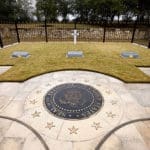As the only state in the union with three presidential libraries, Texas holds a prominent place in U.S. history and its leaders are recognized at world-class institutions that draw hundreds of thousands of visitors every year. These repositories of historical riches document the fascinating lives and times of men who once held the highest office in the land.

George H.W. Bush Presidential Library and Museum
Texas A&M University, College Station, 979.691.4004,
www.bush41.org
Photography courtesy of the George H.W. Bush Presidential Library and Museum.
With more than 100,000 artifacts, 4.5 million documents and 1.5 million photographs and videos preserved for posterity, the George H.W. Bush Presidential Library and Museum offers an immersive experience that is both educational and entertaining.
In the past year, that experience was somber as well. Former First Lady Barbara Pierce Bush (1925-April 17, 2018) passed at age 92, followed seven months later by her husband of 73 years, President George H.W. Bush (1924-November 30, 2018). Their final resting place is on the grounds of the library, next to their daughter Robin, who died of leukemia at age three in 1953. “It has been very busy this year,” says Warren Finch, library director. “Visits went up after Mrs. Bush’s death, then rose again in December after President Bush passed. March of this year has been one of the busiest periods we’ve had.”
But life goes on, as will the continued growth of the library and museum. “We’re always updating the museum with current technology and information,” says Finch, “and we have an active museum program where we rotate traveling exhibits, like the one on display from July 1-January 5, 2020, ‘Wit and Humor: American Political Cartoons.’”
This presidential library was the first one where a visitor could walk into an Oval Office replica and sit behind the desk. Among other additions, plans call for a future full-scale replica of the Oval Office “down the road,” says Finch. “We have a lot of things on the radar.”
For a library and museum with plans to keep expanding, they can expect plenty of help that has been in place for some time, adds David Jones, president and CEO of The George and Barbara Bush Foundation. “President Bush hand-picked about 90 people 25 years ago to serve on his Board of Trustees. That group helped raise the money to build the library. Two years ago we re-engaged the group and added a significant number of folks from the Texas A&M community, inviting them to join the Board of Trustees.” Cordillera Ranch resident Billy Lemmons, trustee of both the Texas A&M Foundation and The George and Barbara Bush Foundation, was one of those. Jones says the efforts of the foundations “will help us attract visitors so we can tell President and Mrs. Bush’s story.”
It’s a story that President Bush himself was astonished to see on his first walk-through at the library, right before it was dedicated in 1997. Jim McGrath, foundation consultant and post-White House spokesman for President George H.W. Bush says he will never forget it. “President Bush was quiet, very quiet,” recalls McGrath. “I said, ‘what do you think, sir?’ He said, ‘It’s very nice, but it’s all about me. There’s too much me.’” That exchange, says McGrath, showed that “the humility that his mother had inculcated into him from a young age was still there. It was vintage George Bush for him to think that his presidential library was too much about himself.”
George W. Bush Presidential Center
Southern Methodist University, Dallas, 214.200.4300,
www.bushcenter.org
Photography courtesy of The National Archives and Records Administration, and the Bush Center.
For the Bush family, politics and public service are definitely a family affair. The firstborn son of George H.W. and Barbara Bush, George W. Bush (July 6, 1946- ) is part of only two sets of father-son presidents in U.S. history (the other being John Adams and John Quincy Adams). The similarity of their names prompted their shortcut nicknames, or 41 and 43. Opened in 2013 and the newest of the 13 U.S. Presidential Libraries, the George W. Bush Presidential Center is home to the George W. Bush Presidential Library and Museum and the George W. Bush Institute (opened 2009) — the nonpartisan, public policy arm of the Bush Center. The Bush Institute focuses on three impact centers: domestic excellence, global leadership, and an engagement agenda on leadership development, policy and taking action on pressing challenges. The Bush Institute Military Service Initiative focuses on post 9/11 veterans and their families. “Portraits of Courage” was a collection of oil paintings by President G.W. Bush that was on display at the Presidential Center in 2017 and is now available in book form. Through October 16, 2019 at the George W. Bush Presidential Library and Museum is a special exhibit “Presidential Retreats: Away from the White House” that features four retreats: Camp David (MD), Prairie Chapel Ranch (TX), LBJ Ranch (TX), and Walker’s Point (ME), and how U.S. presidents have used these special places for work and rest.
LBJ Presidential Library
Austin. 512.721.0200,
www.lbjlibrary.org
As mythic figures go, it would be hard to find anyone more imposing than 36th President Lyndon Baines Johnson (1908-1973), a towering figure at 6’4” in more ways than one. Johnson assumed the mantle of the presidency during one of the country’s darkest hours, taking the oath of office barely two hours after President John F. Kennedy was slain by an assassin’s bullet in Dallas on November 22, 1963. The Bible he swore on is in the LBJ Presidential Library, along with the Presidential Limousine, a replica of the Oval Office reproduced exactly as it looked during LBJ’s White House years, and the Legacy Gallery that sums up the impact that the Johnson presidency had on America: “If you have watched PBS, received financial aid for college, enjoyed wildflowers on the side of a highway, enrolled in Medicare, or visited a national park — then chances are that legislation passed by LBJ has had a direct impact on your life today. Johnson’s vision of a Great Society covered such a wide range of topics that it would be difficult to live a life free from the effects of his Presidency. From the Voting Rights Act and Civil Rights Act to requiring that seat belts be worn in cars, LBJ has made significant changes to everyday life in America.” (Source. lbjlibrary.org/exhibits)













